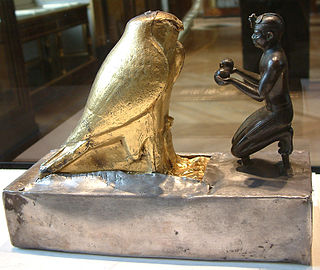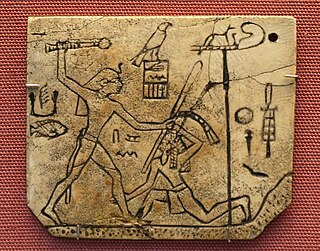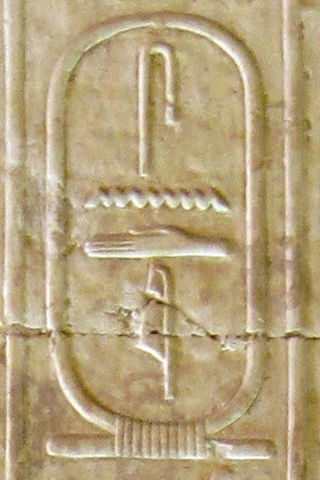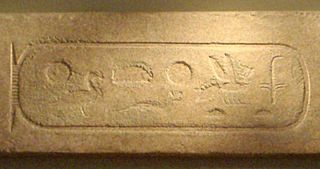
Pharaoh is the vernacular term often used for the monarchs of ancient Egypt, who ruled from the First Dynasty until the annexation of Egypt by the Roman Republic in 30 BCE. However, regardless of gender, "king" was the term used most frequently by the ancient Egyptians for their monarchs through the middle of the Eighteenth Dynasty during the New Kingdom. The earliest confirmed instances of "pharaoh" used contemporaneously for a ruler were a letter to Akhenaten or an inscription possibly referring to Thutmose III.

Hemen is a falcon god in the Ancient Egyptian religion

Pepi II Neferkare was a pharaoh of the Sixth Dynasty in Egypt's Old Kingdom who reigned from c. 2278 BC. His second name, Neferkare (Nefer-ka-Re), means "Beautiful is the Ka of Re". He succeeded to the throne at age six, after the death of Merenre I.

Neferkare Setepenre Ramesses IX was the eighth pharaoh of the Twentieth Dynasty of Egypt. He was the third longest serving king of this Dynasty after Ramesses III and Ramesses XI. He is now believed to have assumed the throne on I Akhet day 21 based on evidence presented by Jürgen von Beckerath in a 1984 GM article. According to the latest archaeological information, Ramesses IX died in Regnal Year 19 I Peret day 27 of his reign. Therefore, he enjoyed a reign of 18 years, 4 months and 6 days. His throne name, Neferkare Setepenre, means "Beautiful Is The Soul of Re, Chosen of Re." Ramesses IX is believed to be the son of Mentuherkhepeshef, a son of Ramesses III, since Mentuherkhopshef's wife, the lady Takhat bears the prominent title of King's Mother on the walls of tomb KV10, which she usurped and reused in the late 20th Dynasty; no other 20th Dynasty king is known to have had a mother with this name. Ramesses IX was, therefore, probably a grandson of Ramesses III.

Usermaatre Setepenre Meryamun Ramesses VII was the sixth pharaoh of the 20th Dynasty of Ancient Egypt. He reigned from about 1136 to 1129 BC and was the son of Ramesses VI. Other dates for his reign are 1138–1131 BC. The Turin Accounting Papyrus 1907+1908 is dated to Year 7 III Shemu day 26 of his reign and has been reconstructed to show that 11 full years passed from Year 5 of Ramesses VI to Year 7 of his reign.

Den, also known as Hor-Den, Dewen, and Udimu, was the Horus name of a pharaoh of the Early Dynastic Period who ruled during the First Dynasty of Egypt. He is the best archaeologically-attested ruler of this period, credited with bringing prosperity to his realm.

Sehertawy Intef I was a local nomarch at Thebes during the early First Intermediate Period and the first member of the 11th Dynasty to lay claim to a Horus name. Intef reigned from 4 to 16 years c. 2120 BC or c. 2070 BC during which time he probably waged war with his northern neighbor, the Coptite nomarch Tjauti. Intef was buried in a saff tomb at El-Tarif, known today as Saff el-Dawaba.

Senedj was an early Egyptian king (pharaoh), who may have ruled during the 2nd Dynasty. His historical standing remains uncertain. His name is included in the kinglists of the Ramesside era, although it is written in different ways: While the Abydos King List imitates the archaic form, the Royal Canon of Turin and the Saqqara King List form the name with the hieroglyphic sign of a plucked goose.

Senakhtenre Ahmose, was a king of the Seventeenth Dynasty of Egypt during the Second Intermediate Period. Senakhtenre reigned for a short period over the Theban region in Upper Egypt at a time where the Hyksos 15th Dynasty ruled Lower Egypt. Senakhtenre died c.1560 or 1558 BC at the latest.
The royal titulary or royal protocol is the standard naming convention taken by the pharaohs of ancient Egypt. It symbolised worldly power and holy might, also acting as a sort of mission statement for the duration of a monarch's reign.

Apepi, Apophis ; regnal names Nebkhepeshre, Aaqenenre and Aauserre) was a Hyksos ruler of Lower Egypt during the Fifteenth Dynasty and the end of the Second Intermediate Period. According to the Turin Canon of Kings, he reigned over the northern portion of Egypt for forty years during the early half of the 16th century BCE. Although officially only in control of the Lower Kingdom, Apepi in practice dominated the majority of Egypt during the early portion of his reign. He outlived his southern rival, Kamose, but not Ahmose I.

Neferkare II was an ancient Egyptian pharaoh of the Eighth Dynasty during the early First Intermediate Period. According to the Egyptologists Kim Ryholt, Jürgen von Beckerath and Darell Baker he was the third king of the Eighth Dynasty. As a pharaoh of the Eighth Dynasty, Neferkare II's capital would have been Memphis.

Neferirkare was an ancient Egyptian pharaoh of the Eighth Dynasty during the early First Intermediate Period. According to the egyptologists Kim Ryholt, Jürgen von Beckerath and Darrell Baker he was the 17th and final king of the Eighth Dynasty. Many scholars consider Neferirkare to have been the last pharaoh of the Old Kingdom, which came to an end with the 8th Dynasty.

Nebka is the throne name of an ancient Egyptian pharaoh of the Third Dynasty during the Old Kingdom period, in the 27th century BCE. He is thought to be identical with the Hellenized name Νεχέρωχις recorded by the Egyptian priest Manetho of the much later Ptolemaic period.

Ankhtifi was a nomarch of Hierakonpolis and a supporter of the pharaoh in Herakleopolis Magna, which was locked in a conflict with the Theban based 11th Dynasty kingdom for control of Egypt. Hence, Ankhtifi was possibly a rival to the Theban rulers Mentuhotep I and Intef I. He lived during the First Intermediate Period, after the Egyptian Old Kingdom state had collapsed, and at a time when economic hardship, political instability, and foreign invasion challenged the fabric of Egyptian society.
Neferka was an ancient Egyptian pharaoh of the Sixth Dynasty, who briefly reigned around 2200 BC.
The Egyptian hieroglyph for "perfect, complete" in Gardiner's sign list is numbered F35; its phonetic value is nfr, with a reconstructed pronunciation of and a conventional Egyptological vocalization of nefer.
Neferkare VIII was the second pharaoh of the 10th Dynasty of ancient Egypt.

Neferkasokar was an Ancient Egyptian king (pharaoh) who may have ruled in Egypt during the 2nd Dynasty. Very little is known about him, since no contemporary records about him have been found. Rather his name has been found in later sources.

The nomen of ancient Egyptian pharaohs was one of the "great five names". It was introduced by king Djedefre, third pharaoh of the 4th Dynasty, as an emendation to the traditional nswt-bity crest. The nomen was later separated from the prenomen to become an independent royal name.















